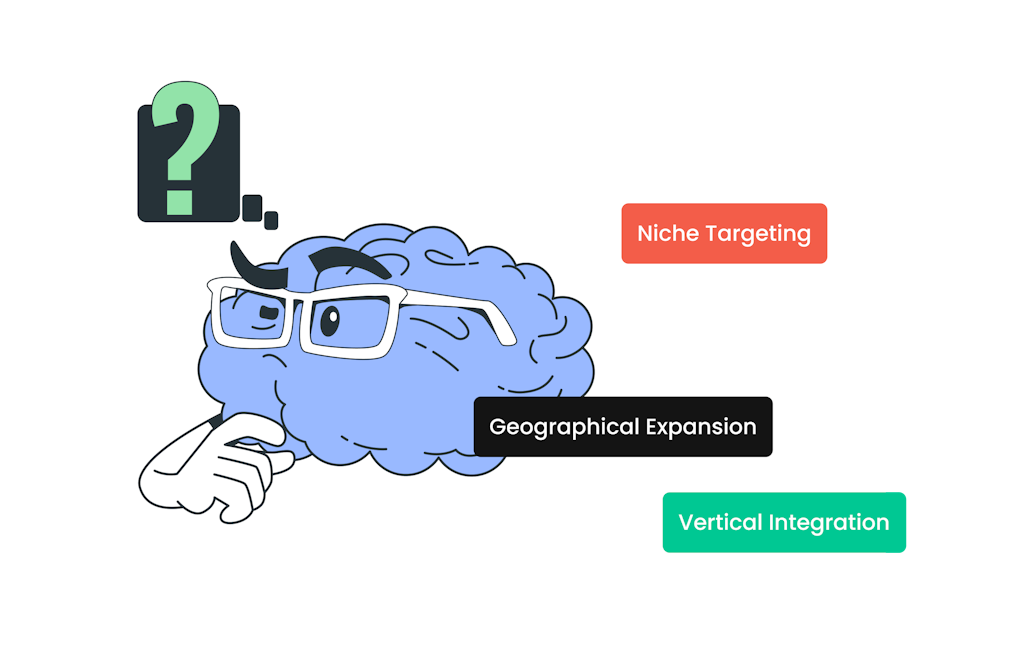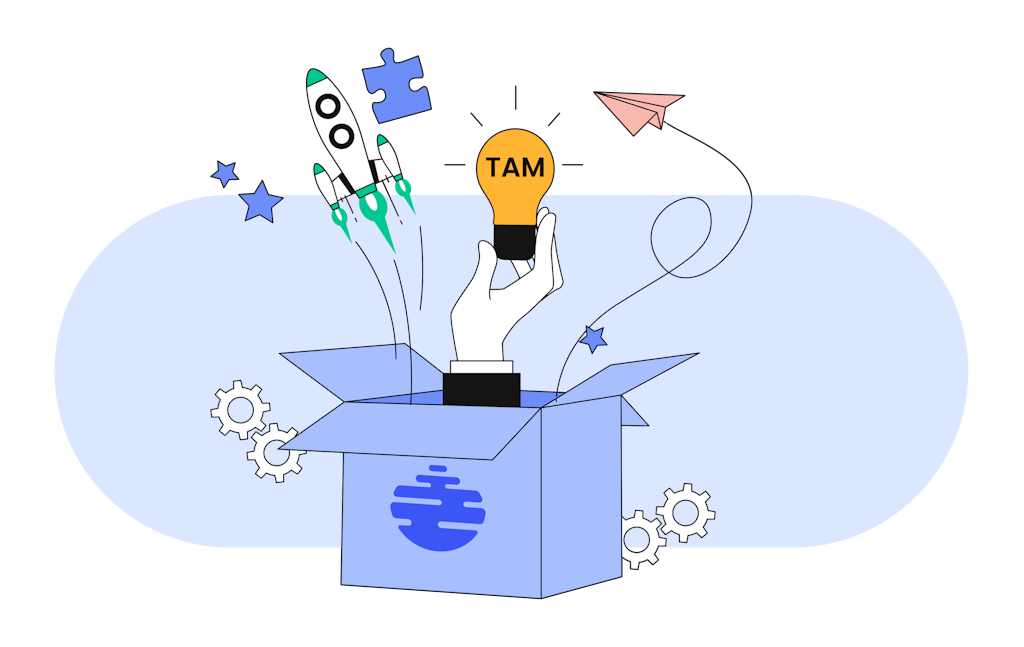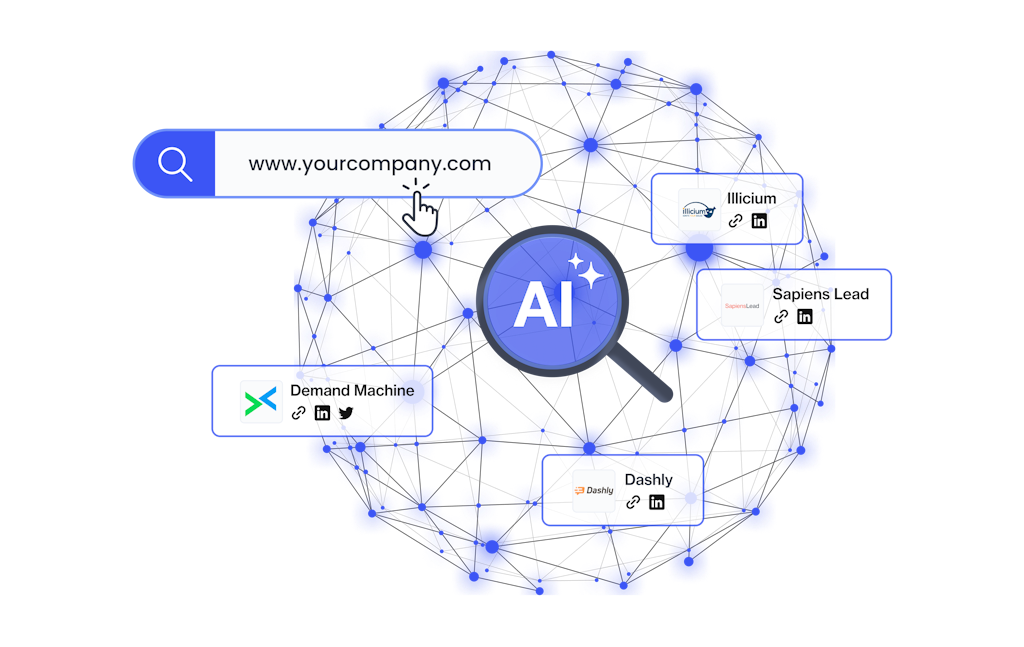Total Addressable Market (TAM)
Total Addressable Market (TAM)

Why TAM Matters for Your B2B Business
Why TAM Matters for Your B2B Business
Total Addressable Market (TAM) is a fundamental concept in marketing that outlines the entire potential market size for a particular product or service. TAM represents the total revenue opportunity available for a business in a specific industry or niche. Here are three reasons why TAM matters for your B2B business:

Identifying Growth Potential
TAM is a quantitative estimate of the total demand for a product or service in a specific market. You can uncover hidden growth opportunities by gauging the size of the market in which your B2B business operates. This knowledge enables you to set realistic growth targets and allocate resources effectively to achieve them.
Focusing Marketing Efforts
TAM analysis allows you to zero in on the most promising segments of your market. Rather than casting a wide net, you can tailor your marketing efforts to reach the right audience. This not only conserves resources but also boosts the efficiency and effectiveness of your campaigns.
Making Informed Decisions
With a clear understanding of your TAM, you can make data-driven decisions. Whether it's entering new markets, launching new products, or optimizing pricing strategies, TAM insights provide the strategic intelligence needed to steer your B2B ship in the right direction.

Calculating Your TAM: The Essentials
Calculating TAM involves several steps, which can vary depending on the industry and the specificity of the product or service. Here are three essential steps to calculate your TAM:
Defining Your Target Market:
Defining Your Target Market:
Accurately define your target market by identifying the specific characteristics of the customers or businesses interested in your offerings. This could encompass factors such as demographics, industry, size, and location.
Estimating Market Size:
Estimating Market Size:
Once you have defined your target market, you'll need to estimate its size. You can do this through market research, data analysis, and industry reports. The goal is to arrive at a figure that represents the total number of potential customers within your target market.
Incorporating Industry Trends:
Incorporating Industry Trends:
Stay informed about industry trends, as market conditions are dynamic. Incorporate these trends into your analysis to calculate your TAM accurately.
TAM is an approximation and can vary over time. Regularly update your TAM analysis to stay relevant and competitive.
Strategies to Expand Your TAM
Strategies to Expand Your TAM
Expanding your TAM involves increasing your market share, entering new markets, or targeting additional customer segments. Here are three strategies to help you achieve this:

Niche Targeting
Explore niche markets within your industry. These smaller, specialized market segments often have unique needs that your B2B business can address. You can increase your TAM and establish a stronger market presence by tailoring your offerings to these niches.
Geographical Expansion
Expand into new geographical regions. If your products or services have the potential to meet the needs of customers in different locations, consider international or regional expansion strategies. This can open up previously untapped markets and increase your revenue potential.
Vertical Integration
Vertical integration involves expanding your business into different stages of the supply chain. This lets you capture a larger portion of the market and increase your TAM. For example, a software company may expand into hardware production to provide complete customer solutions.

TAM vs. SAM vs. SOM: Understanding the Differences
To fully grasp the concept of TAM, you have to differentiate it from two related metrics: Serviceable Addressable Market (SAM) and Share of Market (SOM).
TAM represents the entire market demand for a specific product or service, assuming there are no barriers to entry or competition. It's the maximum revenue opportunity a company can achieve.
SAM is the portion of the TAM that your business can realistically target with your current resources and capabilities. SAM accounts for factors like geographic limitations, regulatory constraints, and competition.
SOM is the percentage of the SAM that your company currently captures or plans to capture. It's a measure of your market share within the serviceable addressable market.
See the magic for yourself
See the magic for yourself
Why waste time on prospects that don't convert?
Get a free trial or book a personalized demo.
Start Now Why waste time on prospects that don't convert?
Get a free trial or book a personalized demo.
Free Trial
Dedicated CSM
Global Coverage
GDPR compliant
Case Study: TAM-Driven Success
Case Study: TAM-Driven Success
Zoom Video Communications is an excellent real-world example of a company that successfully leveraged TAM analysis to drive its growth. Zoom was founded in 2011 by Eric Yuan, entering a crowded video conferencing market with a vision to simplify communication. With prior industry experience, Yuan aimed to address existing solutions' complexity and unreliability.
Zoom's TAM analysis highlighted the vast potential in the video conferencing market, driven by a growing remote workforce and dissatisfaction with existing tools. The company identified the need for a user-friendly, scalable, and cross-platform solution.
Zoom's approach led to explosive growth, reaching over 300 million daily meeting participants during the COVID-19 pandemic. They became market leaders, generating annual revenue of over $2.6 billion in 2020. Today, Zoom has revolutionized remote communication, making it a ubiquitous platform for individuals, businesses, and institutions globally.

See the magic for yourself
See the magic for yourself
Why waste time on prospects that don't convert?
Get a free trial or book a personalized demo.
Start Now Why waste time on prospects that don't convert?
Get a free trial or book a personalized demo.
Free Trial
Dedicated CSM
Global Coverage
GDPR compliant
Leveraging TAM in B2B Lead Generation
Leveraging TAM in B2B Lead Generation
TAM insights aren't just valuable for strategic planning. They can also supercharge your B2B lead generation efforts. Here are three ways you can leverage TAM in B2B lead generation:

Tailoring Messaging:
Tailoring Messaging:
Understanding your TAM allows you to craft more targeted and personalized messaging for your potential customers. You can increase the likelihood of conversion by tailoring your messages to address the specific needs and pain points of different segments within your TAM.
Identifying High-Value Prospects:
Identifying High-Value Prospects:
TAM analysis helps you identify high-value prospects within your target market. These are the customers or businesses with the most significant revenue potential. Focusing your lead generation efforts on these prospects can yield higher returns on investment.
Prioritizing Outreach:
Prioritizing Outreach:
Not all leads are created equal. With TAM insights, you can prioritize your outreach efforts. Allocate your resources to engage with prospects that align closely with your ideal customer profile and are more likely to convert into paying customers.
Knowing your TAM allows you to create highly targeted marketing campaigns tailored to your potential customer's specific needs and preferences.
Data-Driven TAM Insights with Ocean.io
Data-Driven TAM Insights with Ocean.io
TAM provides valuable insights into market potential, resource allocation, and competitive positioning. You can gain a strategic advantage by calculating your TAM and leveraging it in your marketing and lead generation efforts.
At Ocean.io, our primary goal is to help you maximize growth and revenue. Our solutions give you access to comprehensive data on companies and industries, helping you make informed decisions and drive your business forward. Contact us today to start harnessing the power of TAM and propel your business to greater heights.

Transforming Marketing Through Data Intelligence
Transforming Marketing Through Data Intelligence
Ocean.io is a strategic ally for businesses looking to excel in Account-Based Marketing. ABM is a highly targeted approach, focusing on engaging specific high-value accounts rather than casting a wide net.
Discover the multiple ways data intelligence can unlock for your marketing efforts.
Start now Ocean.io is a strategic ally for businesses looking to excel in Account-Based Marketing. ABM is a highly targeted approach, focusing on engaging specific high-value accounts rather than casting a wide net.
Discover the multiple ways data intelligence can unlock for your marketing efforts.
